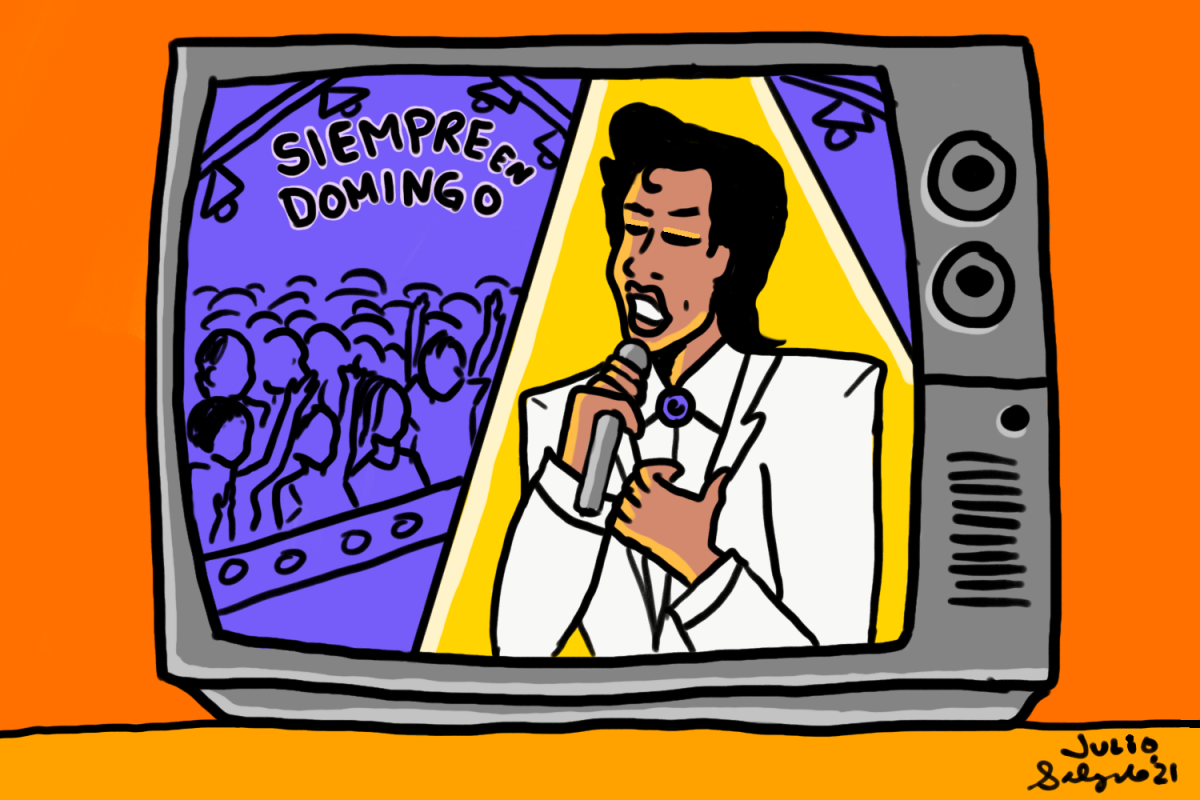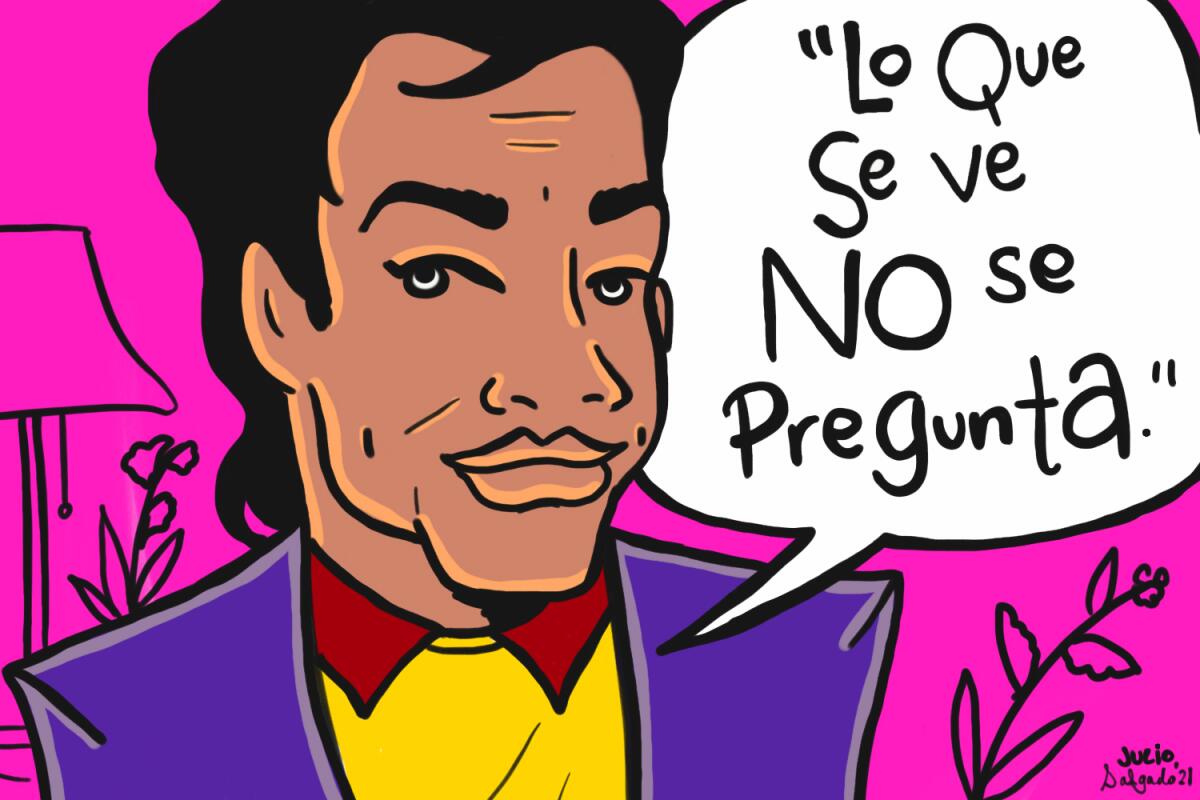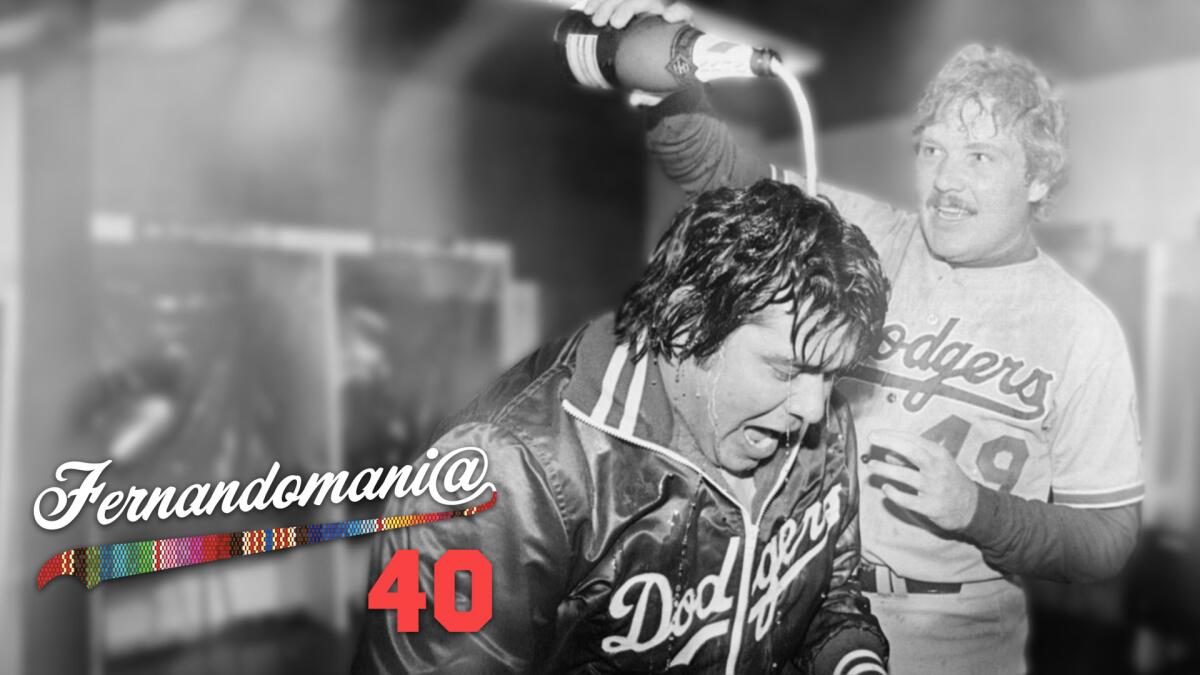Latinx Files: Remembering Juan Gabriel five years after his death

This Saturday will mark five years since Juan Gabriel died.
Of course, the iconic singer songwriter — real name Alberto Aguilera Valadez — isn’t really dead.
His body may no longer be with us, but how can someone who meant so much to people of Mexican heritage on both sides of the border cease to exist?
The Latinx experience chronicled
Get the Latinx Files newsletter for stories that capture the multitudes within our communities.
You may occasionally receive promotional content from the Los Angeles Times.
It’s impossible to sum up the full impact that Gabriel has had on generations of Mexicans and Mexican Americans. It’s more than the songs or the stage persona or the me vale attitude to what you thought about his sexuality. It’s the fact that for many of us he’s a connection to our families (raise your hand if your mom made you clean the house while blasting his music), to our homeland and to our culture. He gave us a shared language that affords us the opportunity to rejoice or grieve as a community.
There are profiles written about the man that are worth your time — I recommend this one published in The Times in 1999 — but for this newsletter we turned it over to our community to tell us how El Divo de Juárez forever changed their lives.
Juan Gabriel and the LGBTQ community

Luis Octavio remembers the first time he saw Gabriel. He was sitting with his family and the singer was about to perform on the weekly Mexican variety show “Siempre en Domingo.”
But all he could focus on was the sequins Gabriel was wearing.
“It gave me a little bit of hope that maybe my jotería would be accepted just the way my abuela, my abuelo, the tíos and everybody else who saw him on that screen accepted his and saw past his flamboyance,” said Octavio, co-founder of the drag bar El Place and one of the organizers of Boyle Heights’ first pride event.
Gabriel’s sexual orientation has always been an open secret. It has always been assumed that he was gay, but it was rarely discussed, with one glaring exception.
During a 2002 interview with news program “Primer Impacto,” reporter Fernando del Rincón asked Juanga point-blank if he was gay. With daggers in his eyes, Gabriel responded with “Lo que se ve, no se pregunta.” What is seen is not asked.
Octavio told me this interview always stood out for him — he described it as iconic, which, yeah, it is — because it told Mexican queer people that being who they were was more than enough and that you didn’t owe anything to anyone.
It’s a sentiment that Nomi B, a drag queen who hosts “Noche de Gringaderas” at El Place, certainly relates to.
“We all knew he was a sister,” she said.
“I admire that he kept his life private and he was like, ‘I don’t care what you think or say about me. I’m going to keep my life private and you’re going to enjoy my music no matter what.’”
Our daily news podcast
If you’re a fan of this newsletter, you’ll probably love our new daily podcast, “The Times,” hosted by columnist Gustavo Arellano, along with reporters from across our newsroom. Every weekday, it takes you beyond the headlines. Subscribe on Apple Podcasts and follow on Spotify.
‘Abrázame que el tiempo es malo y muy cruel amigo’
In 2000, Juan Gabriel released “Abrazame Muy Fuerte,” an operatic banger that makes the case that time is cruel, unforgiving and finite for humans. Because of this, he begs his subject to pend much of that time embraced in each other’s arms. The song was a huge hit and was used as the theme song for a telenovela that shared the same name.
A few years later, it also became my parents’ song.
Around that time, my mom developed a brain tumor. The doctors didn’t know yet if it was malignant, but my family assumed the worst. The prospect of losing our anchor became very real. My dad took it the hardest, and because he is the embodiment of the closed-off macho who tries very hard not to emote, he didn’t have an outlet to let out what he was going through.
So he did what any Mexican would do: He turned to Juan Gabriel.
I was away at college when this happened, but my sister would tell me that he’d play the song nonstop, sometimes sitting next to my mom on the couch with his eyes closed in prayer. It must’ve worked because the tumor ended up benign. Decades later, my mom is the healthiest she’s ever been.
During the pandemic, that song took on an added meaning for me. It was late last year and my parents and I decided to take a road trip. “Abrazame Muy Fuerte” came on. All three of us started singing along, and it wasn’t long before we started bawling. The painful memory came back, but with it came the realization that we still had time and we were spending it together.
That’s the thing about Juan Gabriel’s music. These aren’t just songs. They’re memories. They’re feelings we can’t express, and even if we could, why would we when Juanga’s already done it better?
When I decided to write about Gabriel, I knew that I wanted others to share some of their favorite songs. I asked friends and colleagues to contribute a song for this Spotify playlist and to write a few lines about why they picked that tune.

“Querida”— He’s just so dramatic! Like, “Yes, b—!” (Nomi B, drag queen)
“Amor Eterno” — If there’s a song that defines who Juan Gabriel is, it’s “Amor Eterno.” Since he wrote the song for Rocio Durcal, it’s Juan Gabriel as a song writer. As a singer, his emotion has made it the quintessential Mexican song about heartbreak, regret, and ultimately, trying to make sense out those emotions. With the song’s lyrics and emotions — along with Juan Gabriel being from the Juárez-El Paso borderland — it’s little wonder why “Amor Eterno” was played and sang everywhere in the days following the El Paso massacre. (Roberto José Andrade Franco, writer-at-large at Texas Highways)
“La Frontera” — When I first moved to the U.S. I felt like I didn’t belong here because I didn’t speak perfect English and nobody could pronounce my name. Listening to that song and how he talked about how everybody’s happy at the border and how everyone’s different, it made me feel safe. (Luis Octavio, co-founder of Boyle Heights drag bar “El Place”)
“Inocente Pobre Amigo” — Juan Gabriel was the first poet in my life, a staple at my parents’ home in South Gate, California. My mother owned all of his albums. And when I went away to study literature at the University of Chicago, I took them with me.
I was back in California, walking around in Boyle Heights, when he passed. I got the news alert. Then, all along César E. Chávez Avenue, shop owners blasted his songs. Juan Gabriel wrote hundreds. I know all of them.
For beginners, I recommend “Inocente Pobre Amigo,” which recounts a heartbreaking disillusion but, above all, is a song about valuing yourself. Go on YouTube. Find the version that was recorded during Juan Gabriel’s first concert in Mexico City’s Palace of Fine Arts. Watch him perform with his hands on his hips, glistening in black and gold sequins. Hear him crack jokes with the audience and watch the mariachis on stage try to muffle their laugh. Recall that some elitists thought his work was too lowbrow for the venue.
When Juan Gabriel passed in 2016, his ashes were taken to that same place. For hours on end, hundreds of thousands of people poured in to pay their last respects. I wish I’d been one of them. (Julia Barajas, Los Angeles Times staff writer)
“El Noa Noa”— It’s a song about a place where you can go and be who you are. The ambience of the bar might be different than what people are used to, but it’s about everyone being welcomed and letting them feel like they can be happy. (Melissa Befierce, Mother of Haus of Befierce and events coordinator at El Place)
“No Tengo Dinero”— For me, Juan Gabriel’s songs are tied to memories of me riding on my grandfather’s truck with my aunt and my grandmother on the roads of Campeche where we lived for a few years. Juan Gabriel’s “No Tengo Dinero” is one of his iconic songs because for many it’s always a struggle to have money, but if at least we have love, we know we’ll be alright. (Denise Florez, Los Angeles Times multiplatform editor)
“Have You Ever Seen the Rain? (Gracias al Sol)” — My mom and tías have always been huge Juan Gabriel fans. I grew up in El Paso and he of course has immensely close ties to Juárez, where his career took off. His music is the soundtrack of my childhood. There was a brief time when it was around so much, it annoyed me. But when I moved away from home, that soundtrack became so powerful and comforting. It instantly connected me with my family. My sister, mom and I have sung (poorly) along to “Querida” hundreds of times at this point. But that’s going to be almost everyone’s favorite song. It’s just kind of perfect JuanGa. But the one I’ll choose for this playlist is what I believe is the only cover he ever did: “Have You Ever Seen the Rain? (Gracias al Sol).” In the video, he’s wearing amazing rainbow-colored pants and having so much fun. He brings joy to his work and it’s infectious. He’s also a great singer, so it stays on my playlist along with the much older hits. (Iliana Limón Romero, Los Angeles Times deputy sports editor)
“Hasta Que Te Conocí” — Later brilliantly covered by Ana Gabriel, it is the perfect song about love gone sour, heightened by lyrics that are pure melodrama. (Carolina Miranda, Los Angeles Times columnist)
“Así Fue” — He was never more brilliant, more heartbreaking, more JuanGa than in that song. (Gustavo Arellano, Los Angeles Times columnist)
“Costumbres” — Here’s an extremely on brand story: During one of my family’s chaotic Christmas parties, we were all doing what we usually do—drinking tequila and singing along to a playlist of Juan Gabriel, Rocío Durcal, Alejandro Fernández and, well, you know the vibes. As always, “Costumbres” comes on, the Rocío version, and my trash-talking sister starts to sing loudly, drunkenly, and off-key: No cabe duda que es verdad que la costumbre es más grande que el amor. She looks at me and says, “That’s f— real, dude. La costumbre really is más grande que el amor.” She then scowls at her husband across the room and screams over the music, “F— you, [name redacted]!”
That is the power of “Costumbres.” That’s actually the power of 99.9% of songs written by Juan Gabriel. However, “Costumbres” is god-tier in his canon of songs that have an unbelievable ability to drag your soul. We dance to “Noa Noa,” weep to “Amor Eterno,” raise our arms up to “Querida,” and strongly consider divorce to “Costumbres.”
“Costumbres” is sung from the perspective of a person telling their partner their love has been replaced by resentment, but habit and the comfort of a warm, familiar body keeps them together no matter how many times they try to walk away. Juan Gabriel’s love songs have an uncanny ability to swim in the thick nuances of romance, its brutal pains and exhilarating joys, and as is the case with “Costumbres” the harsh realities of committing your life to someone. He seemingly had a direct line to our deepest fears about love, and expressed poetically something even as mundane as being over it but staying anyway. To quote my sister, that’s f— real, dude. And it’s why “Costumbres” along with so many other songs he penned are elevated to a place of cultural veneration and soundtrack of the most affecting moments of our lives. (Alex Zaragoza, senior culture writer at Vice)
Fernandomania @ 40: El Campeón.

The latest installment of our multi-part documentary series “Fernandomania @ 40” is out today. You can watch here.
When Fernando Valenzuela took the mound in Game 3 of the 1981 World Series, the New York Yankees had a commanding 2-0 lead over the Dodgers and Tommy Lasorda’s crew was facing the real possibility of a third World Series loss in five years to their East Coast rivals. In the end, the Dodgers won the game, 5-4, largely due to the gritty performance of their rookie left-hander. Valenzuela gave up nine hits and seven walks in a 146-pitch complete-game, spurring the team to a World Series victory and cementing his pitching legacy in Los Angeles.
Missed an episode of “Fernandomania @ 40”? You can find them all here.
Consider subscribing to the Los Angeles Times
Your support helps us deliver the news that matters most. Become a subscriber.
Best thing on the Latinternet: The #LigaMXEng community match
Yesterday was the MLS vs. Liga MX All Star Game at the Banc of California Stadium near downtown Los Angeles, but the most important soccer match that took place that day happened hours earlier at a park in Pasadena. That’s where members of the #LigaMXEng community got together to celebrate the beautiful game (and come to terms with how out of shape many of us actually are).
What’s #LigaMXEng? It’s a Twitter hashtag where podcasters, reporters, and fans from around the country congregate to talk about Liga MX, the most popular soccer league in the United States. More importantly, it’s entirely in English, the primary language for many of us. It’s that last part that does it for me.
The Latinx experience chronicled
Get the Latinx Files newsletter for stories that capture the multitudes within our communities.
You may occasionally receive promotional content from the Los Angeles Times.




